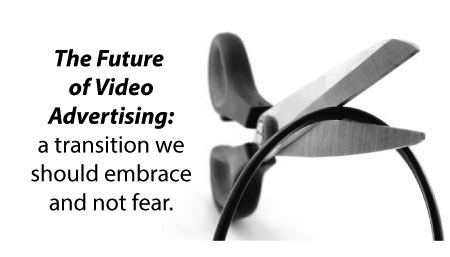
The future of TV…..a Transition We Should Embrace and Not Fear
Another day, another groundbreaking fact to show the shift of how people are viewing media. CNBC just announced that PC sales are down double digits for the year for the first time in history. This holiday season is making it clear, “mobile” (tablet and phone) will surpass PCs in usage in the very near future, which, in turn, will mean that mobile will eventually be our supply line to deliver advertising to the consumer.
This shift is no surprise to us at Burford Advertising. We have been expecting it and embracing new ways to deliver client’s messages. Format needs to be taken in consideration, but no matter where the consumers’ “eyes” are, we will track them down. We now have the ability to target an individual in a specific age group, in a specific zip code, looking for a specific type of product. It’s an exciting time. I have recently been focused on Video Advertising online. New studies show video preroll ads are 2.5 times as effective as other forms of advertising. While one could debate that fact, I think it is clear that online video ads are just as or more effective as traditional TV ads.
There is a crowd that predicts the “end of television.” This is probably the same crowd that predicted the end of all print and the end of all radio. They may be right, but in strict definition only. The way it is delivered is the only thing that is changing. You can define it however you want but in the end, we will still watch shows, news, and sports on a device that has a screen…. There will always be a screen no matter if you call it a TV, a PC, a Tablet, a phone, or some other device yet to be invented. It is ironic that this shift is what will save the television industry.
Yes, the good ole TV has many flaws. TV, like all forms of media, had a bumpy start. It took several decades before we developed the ad platform we know today. TV’s biggest weakness just so happens to be its biggest asset; it is built around “time.” In other words, TV was intended to be “live.” Being “live” is probably the main reason that we don’t get rid of our TV (Cable). We want to watch sports live, we want to watch the news live. I understand that is possible via the Internet, but as consumers, we are just not ready to “cut the cord.”
Cord cutters are “in the single digits” and a new phrase has been created to describe homes like mine, “cord frayers.” As most “cord cutters” have found, you won’t be able to watch CNN, ESPN, etc. on your internet devices live unless you are a cable subscriber and have a login. “Frayers” subscribe to the minimum cable package so they have a login to watch some TV and have a login to be able to watch live TV online. So in that respect, being “live” is extending the life of conventional TV, but it will eventually be its undoing.
Being live creates two major weaknesses: You need channels and you need time slots…. an air traffic control system, if you will, to organize all these shows flying through the air whether anyone is watching or not. People have always wanted to watch most of their TV content on their own time. Long story short, we now have DVRs that allow us to do just that. Although over emphasized, it is cutting into advertising effectiveness and these companies will have no choice but to shift more content online.
Once online, there are no channels, no time slots, hence no need for the DVR and no ability to fast forward through ads!